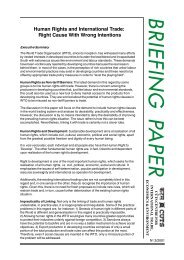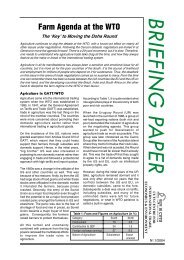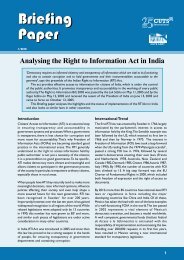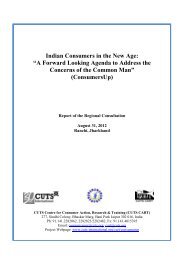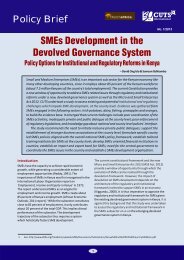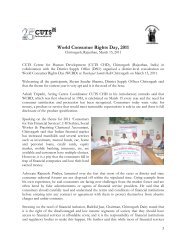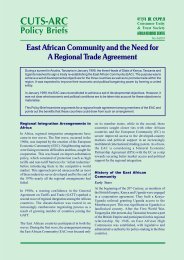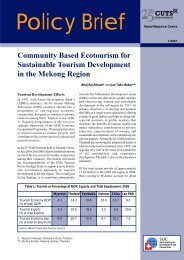Final Report - World Trade Organization
Final Report - World Trade Organization
Final Report - World Trade Organization
You also want an ePaper? Increase the reach of your titles
YUMPU automatically turns print PDFs into web optimized ePapers that Google loves.
promulgated in 1988 had ‘control and display’ of<br />
prices as one of the key areas. This was<br />
subsequently dropped. The case was similar in Sri<br />
Lanka. In Zambia, reduction of inflation levels<br />
remains one of the objectives of competition law. In<br />
countries like India where price control was not<br />
explicitly mentioned as an objective in the competition<br />
law, other laws and regulations have been created to<br />
perform this task in different sectors like<br />
pharmaceuticals, food and a variety of packaged<br />
commodities etc. Such institutions exist(ed) in other<br />
countries as well.<br />
Apart from price control, several other developmental<br />
needs get reflected in the objectives of competition<br />
laws in the 7-Up countries. Zambia, for example,<br />
hopes to encourage innovation, ensure fair distribution<br />
of income and reduce unemployment through the<br />
competition law. The criteria, provided in the<br />
Tanzanian Act for evaluating mergers, explicitly state<br />
that the impact of mergers on employment (capital<br />
vs. labour intensive production), competitiveness in<br />
export markets and ability to face import competition<br />
needs to be considered.<br />
The adoption of competition policy and law is often<br />
a response to existing market realities. One of the<br />
effects of the liberalisation process that the 7-Up<br />
countries have embarked upon has been an increase<br />
in the competitive pressures faced by their domestic<br />
firms. In the pre-liberalisation days many of these<br />
economies had seen significant unrelated<br />
diversification by large firms. The inefficiencies<br />
resulting from such diversification could only be<br />
sustained due to protection. Once the competitive<br />
pressures increased there was a need for corporate<br />
restructuring.<br />
As stated above, in India, South Africa and to an<br />
extent Kenya, this has led to some kind of<br />
consolidation with firms opting out of unrelated areas<br />
and focusing on certain core activities, as well as to<br />
an increase in the number of mergers and acquisitions.<br />
One of the objectives of competition policy and law<br />
could therefore be to properly regulate this process.<br />
The structure of the market has evolved in such a<br />
way that there is a need to redress this by<br />
strengthening the proper functioning of market forces.<br />
In Pakistan, for instance, it was the history of its<br />
corporate sector’s growth during the 1960’s that made<br />
competition policy interventions essential. The<br />
problem was that growth led to the concentration of<br />
wealth in the hands of twenty-two families. Therefore,<br />
the main objective of the competition law that came<br />
into force in 1971 was to prevent the undue<br />
‘concentration of economic power’. 59<br />
A similar situation prevailed in South Africa, where<br />
the five main (white owned) conglomerate groupings<br />
accounted for 83.7 percent of the Johannesburg Stock<br />
Exchange’s (JSE) market capitalisation in 1994. 60<br />
One of the objectives of the new South African<br />
Competition Act that was passed in 1998 and came<br />
into force in 1999, was to further the increase in the<br />
spread of ownership, especially amongst historically<br />
disadvantaged persons. In fact the South African law<br />
makes the most striking statement of development<br />
needs as objectives of competition policy:<br />
a) To promote the efficiency, adaptability and<br />
development of the economy;<br />
b) To provide consumers with competitive prices<br />
and product choices;<br />
c) To promote employment and advance the social<br />
and economic welfare of South Africans;<br />
d) To expand opportunities for South African<br />
participation in world markets and to recognise<br />
the role of foreign competition in the Republic;<br />
e) To ensure that small and medium-sized<br />
enterprises have an equitable opportunity to<br />
participate in the economy; and<br />
f) To promote a greater spread of ownership, in<br />
particular to increase the ownership stakes of<br />
historically disadvantaged persons. 61<br />
59 CUTS, 2002, Competition Regime in Pakistan - Waiting for a Shake-Up, page 19.<br />
60 1994 witnessed the first democratic election in South Africa and is therefore taken as a benchmark. The ANC-led government has<br />
since undertaken a broad legislative programme to address the legacy of apartheid. The top five’s share in JSE market capitalisation<br />
has dropped to 54.7 percent in 1998. See CUTS, 2002, Competition Policy & Law in South Africa - A Key Component in New<br />
Economic Governance, chapter 2, for more on this.<br />
61 Section 2 of No. 89 of 1998: Competition Act, 1998, published in the Government Gazette of the Republic of South Africa, Vol. 400,<br />
Cape Town, 30 October 1998.<br />
Pulling Up Our Socks w 31



